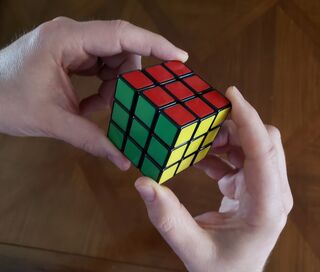Coronavirus Disease 2019
What Do You Know? Facts vs. Truth
Part 4: Tips for living in a postmodern world where facts are at war with truth.
Posted July 27, 2020 Reviewed by Ekua Hagan
In Part 1 of this series, I discussed the illusion of knowledge in the context of COVID-19 and explained how much of what we think we know is actually belief taken as truth because it came from a source in which we have faith. Part 2 dealt with the benefits and limitations of a scientific approach to knowledge. Part 3 addressed postmodernism and how people with a range of intentions attempt to exploit the gaps of our knowledge.
There is a scene in Man of La Mancha, the musical about Don Quixote, in which the character Sansón Carrasco attempts to disillusion the whimsical knight by explaining that there have never been any giants or kings under enchantment and that knights and chivalry haven't existed for three hundred years: "These are facts," Carrasco exclaims, to which Don Quixote defiantly replies: "Facts... are the enemy of truth!"
A "fact," as Don Quixote might define it, is a piece of information that is accurate, but only within a limited context or from a single perspective. However, in contrast to such facts would be Plato's notion of "Truth." According to Plato, Truth refers to the way things are within the realm of the ideal: a dimension of infinite consciousness and perspective that resides beyond our human senses.

With these definitions in mind, a piece of information could be a fact and yet offer only a slight approximation of Truth. For example, the adjacent picture is a two-dimensional (2D) object, and that 2D object is a picture of a color that most of us call "red." We call this color "red" because the light that is reflected back to us from that picture has a frequency of about 650 nanometers, which is in the frequency band that physicists have historically called "red."
These are facts: They are all true, but as you will see, their Truth is limited by specific contextual factors. Here is a larger truth: The picture above of the color red was actually cropped from a three-dimensional (3D) object: a Rubik's cube.

This 3D object has six sides and only one of those six sides is red. Hence, it would only be a partial Truth to say that this 3D object is red when only one of its six sides is red and if you were looking at it from the opposite side, you would not even see the red side. All of this contextual information was obscured in the first picture, as was the larger Truth. It's not that the description of the first picture was a lie, but rather there was a larger Truth that was being hidden.
Now here's where things get really interesting. For millions of people, when they see the first of these two pictures, they don't report it as being "red" — the color of a strawberry — they report seeing the color that most of us call "green" — the color that most of us see when we look at grass. This is because these individuals have a condition that is popularly referred to as "color blindness." For people with this type of color blindness, it is a fact that the color in the first picture is green. But that fact is only true within the limited context of this 2D picture being cropped in such a way that only the side being shown is the one whose color has a wavelength of 650 nanometers, and this color appears to people with a specific type of color blindness as green.
Just to add one more layer of limiting context to the discussion: the only reason why most of us call the color in the first picture "red" (and those with color blindness call it "green") is that we live in America, where most people speak English. However, if instead we lived in India and spoke Hindi, we would call the color in the first picture "laal" (or if we had color blindness, "hara").
Does this difference between facts and Truth sync with your life experiences? Do your experiences validate the notion that this difference is at the root of most conflicts in the world — whether they be small conflicts in your personal life or large-scale conflicts between groups and nations?
Since Gutenberg invented the printing press, each succeeding generation of our species has accumulated knowledge at a faster pace than its predecessor. This increase in cumulative knowledge has spurred the creation of myriad specializations within each area of life. In medicine alone, the number of specialties has grown dramatically in just the past century, not to mention since the days Hippocrates roamed the earth. However, as the cumulative sum of our knowledge as a species expands — with each discipline getting fragmented into smaller and smaller sub-disciplines — we become ever more dependent on the expertise of specialists.

Specialists have a deeper well of knowledge within their respective fields than general practitioners, and their knowledge is far deeper than that of any layperson (even laypersons with access to Google). The relative advantage in knowledge of specialists within a specific field (over generalists and laypersons) grows larger with each generation, and this has made us increasingly reliant on specialists in all fields. For some people, particularly as we wade through the COVID-19 pandemic, this is so unsettling that it has led to them ignoring the recommendations of our top health officials, even though most of these recommendations (like wearing a mask) are not detrimental in any way.
As I conclude this four-part series on epistemology and the illusion of knowledge, I feel it necessary to offer a few recommendations from my experiences — as a clinician, a scientist, and a man who has learned many lessons from his mistakes — to help readers to maximize peace, joy, and stability in their lives.
1. Beware of the Rectangles
Virtually all of the content you absorb from your rectangles — TVs, smartphones, computers, etc. — has been edited to maximize sensationalism. In the process, the information presented on these rectangles is distorted, much like the images in a funhouse mirror, with the goal of stoking your emotions. Therefore, try to limit your exposure to these rectangles as much as possible, and for what you do absorb, suspend your judgment until you get additional layers of confirmation from your direct, personal experiences.
2. Remember the Cube
Just as there is no single perspective from which you can see all six sides of a cube, there is no single perspective from which you can understand all sides of an issue. Therefore, in order to truly understand an issue, get out of your bubble and explore as many perspectives of as many issues as you possibly can: the more sides you see, the closer you will come to approaching the Truth.
3. Balance Faith With Skepticism
When it comes to faith, it is easy to err on either end of the spectrum. If you don't have any faith in experts, specialists, and institutions you can easily become paralyzed with paranoia; but having absolute faith, particularly if it's blind faith, in anyone or anything, can leave you vulnerable to exploitation. Therefore, try to balance your faith with skepticism. Start from a position of faith — in the experts, specialists, and institutions that we've entrusted to keep us informed and safe — but don't be afraid to investigate or challenge the experts and institutions around you when your direct, personal experiences suggest that something isn't quite right.
4. Saying "IDK" Is A-OK
Throughout this article series, I have tried to reinforce that much of what we think we know is actually belief, taken as truth, because it came from a source in which we have faith. It is the ego that pushes us to say that we know something when we really don't. But if there is just one recommendation from this series that you remember, please let it be this: Sometimes, the most honest and courageous thing you can say in a situation is, "I don't know."
References
Parker-Pope, T. (2009). The human body is built for distance. The New York Times, October 26, 2009.




